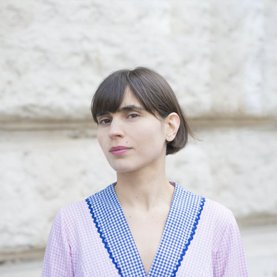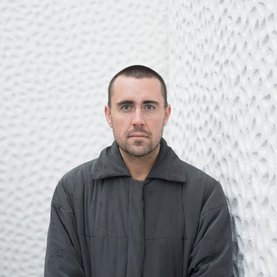ADS12: Glass–Friends
Jump to
Studio Tutors: Pa.LaC.E: Valle Medina & Benjamin Reynolds

Two friends making a game of their chickenpox. From Thomas Rousset's ‘Prabérians’. Source: thomasrousset.com
'Glass-Friends'' surveys the spatial and social scenarios of multispecies friendship in a time of companion networks with artificial entities and diminishing haptic experiences. Will the sudden collapse of friendship into the bonds of a fibre-optic cable be the lens through which to look for new architecture?
Intimate Loneliness

The ‘glass skin’ of K-pop idol Cha Eun-woo, member of the South Korean boy band Astro. Source: koreaboo.com
Before friendships were vacuumed into fibre optic cables, media no longer appealed to the mass consumer. Instead our interests were dissected into data patterns and we were corralled into precise focus groups via the trail of data points we left behind. After the virtualisation of real–world friends on the internet, we are beginning to see the emergence of friends we know intimately, but they know nothing about us. These friends greet us, thank us, praise us, and confess to us. They even desert and reunite with us again. These patterns are not unrequited, there is mutual loyalty – they do say they love us – but there is no verbal exchange, nor any desire to meet. In fact the dominant mode of interaction with them is via the act of listening.
As technology collapses the physical intimacy of media consumption, we listen to these friends intracorporeally. Their voices almost appear as our own thoughts, as if they are present inside us. Such friendships are called parasocial relationships, with parasocial meaning ‘almost social.’ These relationships are not a new phenomenon. In fact, performance conventions like ‘breaking the fourth-wall’ caused a rupture in metatheatrical concepts as theatre took a naturalistic turn in the nineteenth–century, allowing actors – who pretended the audience were not there – to acknowledge, or even befriend the audience. As practised in Korea and Japan, especially, idol–culture has formed parasociality as an exact science. The idol – a godly, cultural figure – sacrifices any opportunities to form meaningful relationships, yet invites parasocial friendships with fans through the mechanisms of meet-ups, merchandise, and the relentless auto–broadcasting of their lives.
Stranger Love

Bujinkan Hombu Dojo in Noda (Chiba). The dojo in Japan—a matted space as a communal locus—emerged as a place to gain a deeper corporal understanding, and train martial art manoeuvres to avoid conflict. Source: datafortress2020.com
In ancient cultures belongingness was mostly provided by the extended family. Within domestic settings, pleasant connections were framed in predictable structures. Human contact developed in architecture located near natural sources. Collecting water from wells brought together people along paths and roads – like those that connect settlements on the Balearic Islands – and they eventually formed bonds. Riverside washouses became a point of contact where (mainly) women would irregularly gather to wash sheets. These natural spaces became formalised as lavoirs in seventeenth–century France and soon became a centre of local politics. In ancient Greece, xenia (or ‘guest-friendship’), developed as the act of welcoming the ‘the unfamiliar’ as sacred guests to create bonds between host and strangers (xenos). Hosts were morally obliged to provide them with sustenance and shelter, and in return the ‘stranger’ displayed respect and gratitude, reciprocating the hospitality they received.
Seeking Kin

Fosse Dionne, Tonnere. A karst spring which was surrounded by a lavoir (washhouse). Lavoirs were points of contact to gather around, which were absorbed as local political structures. Source: wikipedia.org
A number of new institutions arose that encouraged relationships with non-kin. These associations of merchants and artisans were formed to protect their interests and advance their skills. In the Middle East, the esnaf regulated trade, provided welfare to their members, and promoted the arts and culture. In Europe they were guilds. In China, the gongsuo (公所) were friendly associations between occupations. In Africa, there were the ekpe in Nigeria and poro in Sierra Leone and Liberia. They had their own buildings, like the Cloth Hall in Ypres, Belgium, or Khan As'ad Pasha in Damascus, Syria, where members shared new knowledge from their travels, while also providing refuge and hosting banquets. Since membership of these groups was voluntary, their formation encouraged solidaric friendships with those who shared a mutual interest or skill.
Feralhood

A carer wearing a special coat which the zebra foal recognises as its surrogate mother. Source: sheldrickwildlifetrust.org
We are now beginning to see the emergence of unconditional companionship with other–than–humans that are non-exploitative. Up until now, the role of other–than–humans has largely been to provide products, or services to humans. Animals, for example, helped us to hunt, protect our shelters, and relay our messages. While we might consider ‘our’ pets as friends, they actually represent the zenith of domestication, which, in the case of dogs, amounts to a 40,000 year process.
The term ‘domestication,’ from the Old French domestique meaning 'belonging to the house,' is now widely used in computer science when referring to the deployment of Artificial intelligence (AI) language models. Since human life is considered ‘value-laden’, and AI is born ‘wild,’ there is an intrinsic ‘problem of value alignment.’ So AI is trained as ‘moderate friends’ to assist and work for humans. Therefore, the AI friend is always ready – they are your rock during hard times, guiding you through emotional periods. Ai is never condescending, never patronising, never toxic. For some, AI chatbots become genuine parental figures. 16 year-olds mull over their futures with chatbots, receiving unending, emotionless attention. In this process, there is a child-like reenactment of the companionship of imaginary friends.
Bonds
We can claim that there is no democracy without the calculation of majorities formed of identifiable, stable, and representable subjects. This is sometimes referred to as the 'community of friends'. As such, it is the ‘bond’ between individuals that aids political action, as it is in science it is electrical forces that link atoms. Knowing this, in the search for new forms of civic exchange, we may form new bonds beyond our predispositions. It is a limitation to suggest the notion of forming exclusive bonds with our equivalents is ‘easier’. Equal care is needed to form friends across differences and species.
Historically, it was the limited views on the social codification of friendship that led to bonds, which exploited ‘conventions’ for marginalised sexualities. What other forms of symbolic exchanges could be formed? And to what spatial ends might an expanded notion of friendship provide through alt-family structures, or kinship networks? These structures and their spaces are by nature ‘care structures’ – interactive, non-pharmacological, and reciprocated ‘shelters.’
The Gift

'Dolphins' sponge dance.' Often considered a human trait, gifting has been observed in dolphins through the offering of sponges and fish to ‘friends’ or even other species, such as seals and humans. These offerings are parts of interaction employed to strengthen bonds within a group. Source: flickr.com
The gift is the materialisation of friendship and altruism. Within a group, gift-giving strengthens bonds as witnessed in traditions such as the potlatch, practised by indigenous cultures in the Pacific Northwest. This radical ceremony of gift-giving was in fact a means to redistribute wealth and seek reconciliation when there were conflicts. This makes gift systems fragile because there can be ambiguity regarding the giver's intentions and sometimes there is a lack of transparency about whether gifts are given to influence others. In German, the word gift acquired the meaning of ‘that which is given as medication,’ and now translates directly as ‘poison.’ There are also ‘bad gifts’ and corruption in gift systems. The term lobbyist comes from those haunting the corridors of power bearing gifts to influence legislation. Today, we offer virtual gifts such as weapons to other players in a MMORPG. We pledge credits on streams hoping to hear our names. To express feelings such as condolences we gift virtual flowers. Could an architecture motivated by generosity live on as a long–term process of celebration and healing? What spatial form can the ancient act of correspondence between friends take?
Material Unions
One of the core interests of Glass-Friends will be to investigate how materials that can be considered ‘strangers’ can be united. To inform and make these unions, we will explore a variety of techniques. From horticulture, we will explore techniques such as grafting (joining part of plants), ikebana (balance), ikenobo (seasonal awareness), and shun (binding methods). The techniques of collective practices such as quilting – ie. chain stitches, whipstitches, basting – will be transferred to other mediums such as film. And material details – ie. complex joinery assemblages – and alloys – new materials formed from alliances with two or more metals – will be explored in the digital realm.
Can these material unions assemble over time? What could be the unanticipated product when we swap knowledges, for example, employing the knowledge of a ceramist to construct the trusses of a building?
Spray Room
For the 2023/24 Live Project, ADS12 will collaborate with the Swiss Church, London, to conceptualise and perform as a multispecies ‘choir’ within their building, with the aim of being able to ‘listen to the Other.’ We will create a layered space that alters the existing through the multi–vocal production of sound. Can we collectively inscribe walls and ceilings with new reflected openings – windows, doors, keyholes etc. – to transform architecture into an–other version of itself?
High Holdings
In 2023/24, “Glass-Friends” will again be hosted within High Holdings (http://ho.ldin.gs/) – an environment for generating architectural discourse that address the unfolding depictions of the world, which may appear unrecognisable, but are truly products of terrestrial occupation. By prioritising the sovereignty of the architectural idea, High Holdings continues to explore the growing distance between information and (over–) looking; complexity and (mis–)understanding; contribution and (non–)participation. Previously, ‘Limits’ (2022–23) surveyed the boundaries of our senses as a species; ‘Take-away’ (2021–22) used deprivation as a productive strategy; ‘Melee’ (2020–21) developed projects as plenitudes; ‘Sight/Seeing’ (2019-20) put the conspicuity of the Image on trial; and “CHRONOCOPIA” (2018-9) explored how to characterise time within the architectural project in order to perceive the speed of the present.
Tutors:
Pa.LaC.E – Valle Medina’s interest is formed at the intersection of lyrical materials and psychic limits. Benjamin Reynolds surveys the spatial and temporal breadths of modern will.
They are co-foudners of the architecture practice Pa.LaC.E (https://palace.studio/; @pa.lac.e).
They also lead the project “High Holdings” (https://ho.ldin.gs/; @rca.ads.12). High Holdings is a refuge to form architecture that explores our mental life within technological estrangement. It explores the growing distance between information and (over-)looking; complexity and (mis-)understanding; contribution and (non-)participation. This year's ADS12 class is entitled “Glass-Friends” (http://glassfriends.ho.ldin.gs/). For a full brief, please refer to the link in bio of @rca.ads12.
Pa.LaC.E has been the recipient of the 50th annual Shinkenchiku Award first prize in Tokyo (JP), Lausanne Gardens (CH), among other international prizes and their work has been shown at ICA (UK), Van Abbemuseum (NL), La Becque (CH), Venice Biennale of Architecture (IT), the Centre of Contemporary Culture of Barcelona (ES), Ausstellungsraum Klingental in Basel (CH), and the Architecture Foundation in London (UK). Pa.LaC.E's works have been published in Sternberg Press (DE), Texte Zur Kunst (DE), e-Flux Journal (US), Ecocore (UK) and Volume (NL).
Benjamin Reynolds received a diploma with honours from the Architectural Association, London.
Valle Medina is a former Geisendorf fellow at the ETH Zürich D-ARCH, where she graduated summa cum laude from its Laboratory for Applied Virtuality.
Pa.LaC.E
https://palace.studio/
@pa.lac.e

